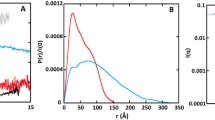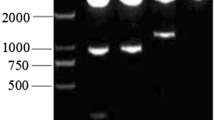Abstract
The secondary structure of the toxin fromBacillus thuringiensis subsp.kurstaki (Btk) HD-73 was estimated by Raman, infrared, and circular dichroism spectroscopy, and by predictive methods. Circular dichroism and infrared spectroscopy gave an estimate of 33–40% α-helix, whereas Raman and predictive methods gave approximately 20%. Raman and circular dichroism spectra, as well as predictive methods, indicated that the toxin contains 32–40% β-sheet structure, whereas infrared spectroscopy gave a slightly lower estimate. Thus, all of these approaches are in agreement that the native conformation of Btk HD-73 toxin is highly folded and contains considerable amounts of both α-helical and β-sheet structures. No significant differences were detected in the secondary structure of the toxin either in solution or as a hydrated pellet.
Similar content being viewed by others
References
Andrews, R. E. Jr., Faust, R. M., Wabiko, H., Raymond, K. C., and Bulla, L. A. (1987).CRC Crit. Rev. Biotechnol. 6, 163–230.
Argos, P., and MohanaRao, J. K. (1986).Methods Enzymol. 130, 185–207.
Bietlot, H., Carey, P. R., Choma, C. T., Kaplan, H., Lessard, T., and Pozsgay, M. (1989).Biochem. J. 260, 87–91.
Bietlot, H., Vishnubhatla, I., Carey, P. R., Pozsgay, M., and Kaplan, H. (1990).Biochem. J. (in press).
Brousseau, R., and Masson, L. (1988).Biotech. Adv. 6, 697–724.
Byler, D. M., and Susi, H. (1986).Biopolymers 25, 469–487.
Carey, P. R. (1982).Biochemical Applications of Raman and Resonance Raman Spectroscopies, Academic Press, New York, pp. 48–70.
Carey, P. R., Fast, P., Kaplan, H., and Pozsgay, M. (1986).Biochim. Biophys. Acta 872, 169–176.
Chang, C. T., Wu, C. S., and Yang, J. T. (1978).Anal. Biochem. 91, 13–31.
Chen, G. C., and Yang, J. T. (1977).Anal. Lett. 10, 1195–1207.
Chen, Y. H., Yang, J. T., and Martinez, H. M. (1972).Biochemistry 11, 4120–4131.
Chou, P. Y., and Fasman, G. D. (1979).Biochemistry 13, 211–222.
Dev, S. B. (1987).J. Biol. Physiol. 15, 57–61.
Fraser, R. D., and Suzuki, E. (1966).Anal. Chem. 38, 1770–1773.
Garnier, J., Osguthorpe, D. J., and Robson, B. (1978).J. Mol. Biol. 120, 97–120.
Harada, I., and Takeuchi, H. (1986). InSpectroscopy of Biological Systems (Clark, R. J., and Hester, R. E., eds.), John Wiley and Sons, New York, pp. 113–175.
Kauppinen, J. K., Moffatt, D. J., Mantsch, H. H., and Cameron, D. C. (1981).Appl. Spectrosc. 35, 271–277.
Lippert, J. L., Tyminski, D., and Desmeules, P. J. (1976).J. Am. Chem. Soc. 98, 7075–7080.
Lord, R. C., and Yu, N. T. (1970).J. Mol. Biol. 50, 509–524.
Nagmatsu, Y., Itai, Y., Hatanaka, C., Funatusu, G., and Hayashi, K. (1984).Agric. Biol. Chem. 48, 611–619.
Parker, F. S. (1983).Applications of Infrared, Raman, and Resonance Raman Spectroscopy in Biochemistry, Plenum Press, New York, pp. 83–155.
Pozsgay, M., Fast, P., Kaplan, H., and Carey, P. R. (1987).J. Invertebr. Pathol. 50, 246–253.
Provencher, S. W., and Glockner, J. (1981).Biochemistry 20, 33–37.
Surewicz, W. K., and Mantsch, H. H. (1988).Biochim. Biophys. Acta 952, 115–130.
Surewicz, W. K., and Mantsch, H. H. (1990). InProtein Engineering—Approaches From the Classical to the Genetic (Narang, S., ed.), Butterworth, New York, pp. 131–157.
Thomas, G. J. Jr., and Prescott, B. (1983).J. Mol. Biol. 165, 321–356.
Tu, A. T. (1986). InSpectroscopy of Biological Systems (Clark, R. J., and Hester, R. E., eds.), John Wiley and Sons, New York, pp. 47–112.
Yang, J. T., Wu, C. S., and Martinez, H. M. (1986).Methods Enzymol. 130, 208–269.
Author information
Authors and Affiliations
Rights and permissions
About this article
Cite this article
Choma, C.T., Surewicz, W.K., Carey, P.R. et al. Secondary structure of the entomocidal toxin fromBacillus thuringiensis subsp.kurstaki HD-73. J Protein Chem 9, 87–94 (1990). https://doi.org/10.1007/BF01024989
Received:
Published:
Issue Date:
DOI: https://doi.org/10.1007/BF01024989




